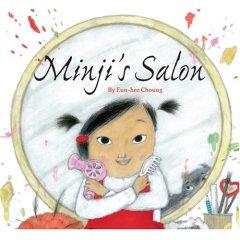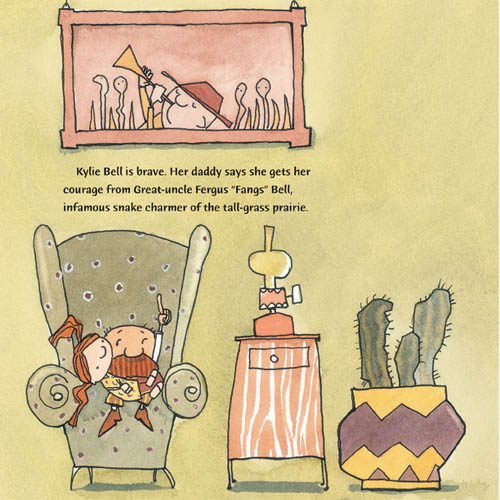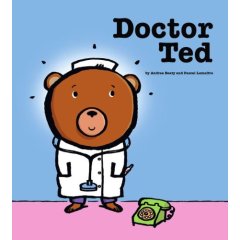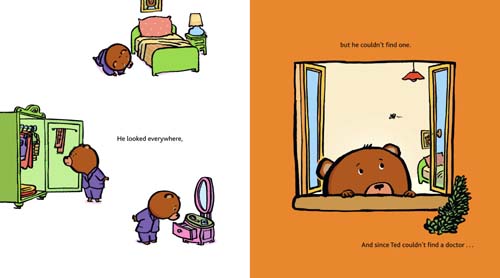Illustration Matters: Choung, Dormer,
Lemaitre, and Tankard are in the house
 March 12th, 2008 by jules
March 12th, 2008 by jules
It’s time once again to take a look at some of my favorite new picture books, but instead of merely reviewing them, we’ll take a peek inside at some of the art work therein, thanks to either the illustrator him or herself or the publisher. I have four books this week, and — since it would pain me to have to pick a favorite — I’ll put them in alphabetical order by illustrator. Yup, everything’s coming up Eun-hee Choung, Frank Dormer, Pascal Lemaitre, and Jeremy Tankard this week. Let’s get right to it then.
So, just take a look at what Minji is up to while her mother is away at the salon, getting her hair dyed a blazingly cool shade of red (illustrations used with permission from publisher):

This is from Minji’s Salon by South Korean illustrator Eun-hee Choung (Kane/Miller, February 2008), who was awarded the grand prize in the Korean Published Arts Contest in 2005. Her goal is to “make unique picture books,” and she undoubtedly succeeds with this one, originally published in South Korea in 2007.
 Before we even get to the CIP and title page, Choung gets right to work, treating us to two intriguing spreads that propel us forward: one spread of a city street, almost empty except for the tail end of Minji’s dog running on to the next page, and a second spread of Minji on tiptoes, peering into the window of Jang’s Hair shop, as her brunette of a mother prepares to get her hair done. On the title page, Minji’s simply all fired up and running forward, just as her dog had done before: Her very active imagination has prompted her to head home to set up her own salon. Chang sets up most of the rest of the story with her mother’s salon experience on the left and Minji’s attempt to color her dog’s hair at home on the right. Hoo hah! No parental supervision; this should be interesting, to say the least! There’s a lot of humor here (on one spread, the male hairdresser shows Minji’s mother a picture of a potential hair style; on the right, we see that Minji has put a very wacky, fuzzy headband with pom-poms on her dog’s head: “Perhaps something like this?” the text says. Both Minji and her mother grimace). The hairdresser mixes his colors; Minji heads to the fridge to mix up some ice cream. The hairdresser gets to work; Minji starts rolling the dog’s hair with crayons and frozen confections: “You have to be patient; beauty takes time.” And so it goes…
Before we even get to the CIP and title page, Choung gets right to work, treating us to two intriguing spreads that propel us forward: one spread of a city street, almost empty except for the tail end of Minji’s dog running on to the next page, and a second spread of Minji on tiptoes, peering into the window of Jang’s Hair shop, as her brunette of a mother prepares to get her hair done. On the title page, Minji’s simply all fired up and running forward, just as her dog had done before: Her very active imagination has prompted her to head home to set up her own salon. Chang sets up most of the rest of the story with her mother’s salon experience on the left and Minji’s attempt to color her dog’s hair at home on the right. Hoo hah! No parental supervision; this should be interesting, to say the least! There’s a lot of humor here (on one spread, the male hairdresser shows Minji’s mother a picture of a potential hair style; on the right, we see that Minji has put a very wacky, fuzzy headband with pom-poms on her dog’s head: “Perhaps something like this?” the text says. Both Minji and her mother grimace). The hairdresser mixes his colors; Minji heads to the fridge to mix up some ice cream. The hairdresser gets to work; Minji starts rolling the dog’s hair with crayons and frozen confections: “You have to be patient; beauty takes time.” And so it goes…


…until her (saint of a, I must add) mother gets home. Sure, she’s appalled, but then she gives Minji one of those tsk-tsk smiles, the kind of happy “you silly girl” looks that impossibly suburban soccer-moms on things like day-time disinfectant commercials give their kids after they’ve done something like finger-painted on the walls. Who are these mothers, and are they aliens? But I digress. Safe to say that Choung is setting out to perhaps make a statement about the insanely wonderful creativity of children but also the tremendous patience that parenting asks of adults who spawn. Though the aforesaid commercials, when I happen to actually see them, make me want to kick the television, Choung doesn’t. This tsk-tsk moment actually works in this book. There’s much to enjoy here — Choung’s finely-detailed spreads, her composition choices, the expressive players in this story, and especially the juxtaposition of the left side of the spread to the right. The action explodes over in Minji’s world, while the salon experience is tightly contained in borderless but clean, rectangular illustrations, centered in generous white space, on the left of each spread (except for the occasional piece of paper or paint that is flung over from the right side of the spread to the left, which is a nice touch).
A funny, exuberant take on the creativity of children as well as their need to play grown-up — and dress-up — when the inspiration strikes them. I look forward to what Choung brings us next.
 Next up is one of my favorite picture books thus far this year, Not So Tall for Six by Dianna Hutts Aston and illustrated by Frank Dormer (Charlesbridge, February 2008). Holy fear-frozen jackrabbits, it is funny and both written and illustrated with such, well . . . oomph and style that I find it is a must-must-have. As in, if I had a boxful of these books, I’d stand on the street corner and hand them out and make everyone’s day.
Next up is one of my favorite picture books thus far this year, Not So Tall for Six by Dianna Hutts Aston and illustrated by Frank Dormer (Charlesbridge, February 2008). Holy fear-frozen jackrabbits, it is funny and both written and illustrated with such, well . . . oomph and style that I find it is a must-must-have. As in, if I had a boxful of these books, I’d stand on the street corner and hand them out and make everyone’s day.
Meet Kylie Bell. She is small for six, and she “comes from a long line of not-so-tall people. But the Bell family has never let size get them down. Nope. The Bell family motto is ‘Brave and smart and big at heart.'” And brave Kylie Bell is, indeed. Here she is with her daddy, as he points out a bit of a family fun fact (this illustration was featured here at 7-Imp back in July, and illustrator Frank Dormer — who has updated his site, I see, complete with a very funny front page — is allowing us to feature it once again):

Now, if the cover illustration alone and the above one don’t make you laugh, I’m sorry to say that you need to get your funny bone checked (that is such a six-year-old’s joke, no? I need to get out more). Turns out that one of Kylie Bell’s classmates, “that new bully-boy Rusty Jacks slithering around like a half-starved rattlesnake,” makes her a wee bit nervous, despite her family’s long history of great courage. In one joyful spread, Kylie imagines herself towering — both literally and figuratively — over this bully, and it’s too fabulous to not share with you here:
At times like this a sneaky thought tip-tippity-two-steps across Kylie Bell’s brain. She is so tall, the ground rumbles like a mighty oil gusher when she runs. She is so tee-totally-tall, big kids can play hopscotch in her shadow.
She is so positively giraffelike, she gets a permanent crick in her neck from looking down at the tops of her friends’ heads. Sigh.
And, even though she’s “not a moper . . . nor a pouter, nor a whiner . . . above all, {she’s} a proud member of the Bell family,” Rusty Jacks still puts some fear in her heart. Eventually, she stands up to him (“her legs feel like a Aunt Cherokee’s cactus jelly,” yet for “a split second Rusty Jacks looks like a fear-frozen jackrabbit”), and, better yet, she surprises Rusty and her entire first grade class with an unexpected act of kindness and empathy toward Rusty at the book’s close, resulting in “one brief shining moment” of Kylie Bell looking down upon the tops of everyone’s heads (again, both literally as well as metaphorically).
It would simplify this book-with-the-big-‘ol-BIG-‘OL-heart entirely too much to say it’s about school bullies, which — on one level — it is. It’s also a very funny, touching-but-never-cloying tale of pluck and grit and generosity. Dianna Hutts Aston, arguably best known for her two books on the natural world, tells this tale in an almost lilting (lilting in a country-western way of speaking, if that makes sense) and rhythmic verse (“Kylie Bell skedaddles faster than a spooked horse”), and Dormer’s dramatic, action-packed illustrations — rendered heavily on an earth-toned palette, setting the tale in the American Southwest — are endearing and engaging. Kylie Bell leaps off the page in all her spunk and personality, and I love how much expression Dormer can get from a character with merely dots for eyes and half-circles for noses.
Don’t miss the chance to introduce your favorite wee one(s) to the heroic Kylie Bell, especially if you find yourself reading aloud to children often. Perfect, perfect story time choice.
(See also Jen Robinson’s February review of this title.)
 Since we were on the subject of a child’s imagination (with the first title), let’s meet the young, ursus-tastic physician of Doctor Ted by Andrea Beaty and illustrated by Pascal Lemaitre (Margaret K. McElderry Books, April 2008). Ted takes a day or two trying on the medical profession for size, simply because he wakes up, bumps his knee, realizes he needs a doctor, but can’t find one (illustrations used with permission from publisher). Right off the bat, author Andrea Beaty shows us yet again her ability to get smack-dab into the center of a child’s way of thinking:
Since we were on the subject of a child’s imagination (with the first title), let’s meet the young, ursus-tastic physician of Doctor Ted by Andrea Beaty and illustrated by Pascal Lemaitre (Margaret K. McElderry Books, April 2008). Ted takes a day or two trying on the medical profession for size, simply because he wakes up, bumps his knee, realizes he needs a doctor, but can’t find one (illustrations used with permission from publisher). Right off the bat, author Andrea Beaty shows us yet again her ability to get smack-dab into the center of a child’s way of thinking:


And this book is terrifically funny, too: Ted immediately sets up his own office in his room, ripping apart his curtains to create a bandage, and waiting, waiting, and waiting some more for his first patient to show (as he’s waiting, he thinks, “Nice waiting room,” which makes me laugh out loud as well as the children I’ve read it to. Analyze why, and it’ll immediately become unfunny, but suffice it to say it’s one of those random thoughts young children tend to have which shines a light on their bottomless reservoir of patience when it comes to this type of play, whereas an adult would have pulled his or her hair out by this point). Finding no patients, he makes a “house call” — “‘Hello?’ he called throughout the house” (bah dum ching!) — telling his mother that his freckles are measles and she needs an operation (“Eat your breakfast,” she tells him). Later, he tells his teacher that she has mumps and needs crutches (“‘Those are my cheeks…Eat your lunch'”) and his principal that he has both gingivitis and bad breath, requiring both a body cast and a shot. This is laugh-outloud stuff for young children, and Beaty really nails a child’s need to play-pretend, to learn through role-play, and to simply assert himself in a world full of adults and their tendency to sometimes dismiss this type of imaginative play (note how many times an adult tells Ted to just hush and eat already). In the end, Ted saves the day and isn’t so readily dismissed. A funny, empowering tale for the wee’est preschooler or elementary school student with the most colorful of cartoon-esque illustrations by Lemaitre, who populates Ted’s school with a bright menagerie of creatures and staff. Another new hero of children’s lit: Doctor Ted saves the day (and, lucky for us, we might see him again, since he finds himself needing a fire truck at the book’s close).
Ouch, it hurts to put this one last, but then I did promise to do these in alphabetical order by illustrator, didn’t I? I have said this before, and I’ll say it again: I think Jeremy Tankard is making some exciting books and I’m so glad he is contributing to the world of children’s lit. I raved about last year’s Grumpy Bird ’til I was blue in the, uh, fingers, and every time I see the art, in particular, in that book it still makes me happy. And now here’s Tankard’s second picture book, Me Hungry! (Candlewick, April 2008). Part of what I love about Grumpy Bird is the touch of whirly-swirly, flowery, mixed-media psychadelia, for lack of a better word, in some of Tankard’s paintings, and there’s just a tiny touch of those eye-popping drops-of-paint moments in the texturized backgrounds of his art work in this title, but overall, it’s simpler and, well, more down-to-earth. It tells the tale of a stone-age boy who needs a bit of food as well as, it turns out, some simple companionship. But, though our protagonist here lived bajillions of years ago (to be precise), his needs are universal ones, indeed: His dad is too busy (“Me busy!”, pictured here without the text, and thanks to Tankard for sharing the images), and his mom is, too (in what I think is a laugh-outloud-funny spread, the mother with three children and that very fatigued early-motherhood-is-a-lot-like-boot-camp-please-leave-me-alone look).
Deciding to take matters into his own hands, he goes hunting. When he comes upon a rabbit and declares he’ll eat it (“Me eat rabbit!”), you’ll hear more laughs from children, what with the rabbit’s wide-eyed, hubba wha did you say? look and, later, with the same look from the boy when he foolishly attempts to hunt a porcupine, who then declares “No! Me sharp!” and a saber-toothed tiger who roars, “No! Me mean!” It’s when he meets a woolly mammoth that things turn around — but for the good, which I won’t spoil for you. I’ll only say that the boy finally makes a friend who gives him the attention and validation he needs, much as with Doctor Ted above.
And, I have to quickly add, the funniest part of all is at the book’s close when his father calls him in for dinner: “EDWIN, DINNER!” Edwin? Who knew the most popular boy’s name during the Paleolithic era was “Edwin.” Funny stuff. But subtle and understated, one of Tankard’s many charms. Blink and you might miss it.
Tankard uses a very economical text here (and me put that mildly): “No sentence ever contains more than three words, but the emotions are deftly conveyed,” wrote Betsy Bird in her detailed review. The illustrations in this title, as mentioned above, are also economical and spare, and it works to great effect. I think it’s clear that Tankard draws inspiration from Japanese artists. Tankard relies on a heavy use of black line, and it’s remarkable how much expression he can get out of a character or composition with a few bold lines. Wrote Betsy,
I was also mighty fond of the tiny details Tankard was able to sneak in. I liked noticing that the title page of this book shows Edwin staring down at a stomach that is clearly making noise, even if that sound is only perceivable through six thick lines. I liked that the important job his dad couldn’t tear himself away from was busting open a peanut with a club. And I liked that the rabbit Edwin intends to eat has this baggy-eyed, panicked stare, as if it had been harboring prehistoric ulcers for months. Everything from Edwin’s caveboy sneakers (reminiscent of Grumpy Bird’s) to the omnipresent apple tree is eye-catching and rewards second and third readings.
This one’s a winner, and might I add that no one does those sneakers quite like Tankard? Highly, highly recommended.
{Fun Fact: David Elzey’s November Blogging for a Cure interview with Tankard reveals the soundtrack for composing Me Hungry! “Industrial flavoured music” — I can see that!}

Thanks for featuring these yummy books! Love Edwin and Kylie Bell. Me want them!
Wow. Such diverse styles, all wonderful. I love the sneakers, too! I used to wear orange Vans every day.
Yay for Dianna Hutts Aston! She’s great, and I love all of the illustrators.
[…] So Tall for Six by Dianna Hutts Aston (Charlesbridge, February 2008) — reviewed here at 7-Imp (really, have you seen this wonderful book […]
[…] Eun-hee Choung in March […]
[…] organic and ‘painterly’ than in Grumpy Bird, something that I learned while working on Me Hungry! I’m really proud of the backgrounds in Boo Hoo Bird. This was necessitated by the forward […]
[…] publications). Here in the U.S., he has brought us titles such as Andrea’s 2008 picture book, Doctor Ted (Margaret K. McElderry Books). Pascal knows how to bring us the Grimm-esque, but he also knows how […]